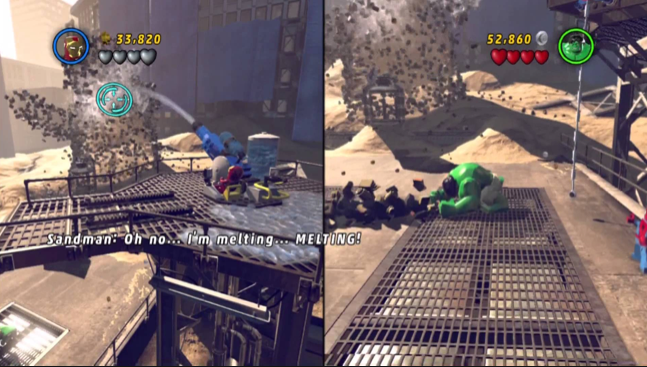 I recently came across an article entitled “Between the Lines: Games and Diegesis,” in which Ian McCamant interrogates the manner in which games tell stories and the manner in which they tell stories differently than literature or film. And since these are subjects I usually find myself engaging with, McCamant’s discussion of things like mimesis and diegesis has me thinking a lot about the narrativity of video games.
I recently came across an article entitled “Between the Lines: Games and Diegesis,” in which Ian McCamant interrogates the manner in which games tell stories and the manner in which they tell stories differently than literature or film. And since these are subjects I usually find myself engaging with, McCamant’s discussion of things like mimesis and diegesis has me thinking a lot about the narrativity of video games.
Indeed, McCamant explains,
It is common practice to think of games, in their narrative capacity, as a purely mimetic form. A game places you in a fictional scenario, in the shoes of a character or characters through which you experience a phantasmal world. You interact directly with a world represented through the art direction, mechanical design, etc. of the game. To some, it may be satisfactory to leave it at that. However, recent trends in indie titles hint at a more experimental orientation to narrative which not only presents something new, but also warrants a revisiting of how exactly a story is experienced in an interactive framework. Such a revisitation reveals the simple classification of game narrative as mimetic is problematic.
And in order to unpack the problematic classification of games as a mimetic form, McCamant first works to define some of his terms: “In literature, diegesis refers to a manner of storytelling whereby the story is recounted, as opposed to mimesis, in which the story is represented directly. In film, the term has a different meaning, referring to whether an element of the film takes place at the level of the story or the level of the reader…Games are in the unique position to bring these two meanings together.” And, ultimately, McCamant finds games’ “unique position” to be significant because it “opens the door to new possibilities for storytelling and avant garde experimentation in the medium. Even more fundamental than the pretentious potential for deconstructionism and semiotics within games as literature, the quasi-diegetic space games naturally occupy, as entities of both story and interface, allows for new questions of narrative altogether.”
 In order to think further about these new possibilities for storytelling and these new questions of narrative, McCamant discusses a few specific types of games as being emblematic of this “quasi-diegetic space games naturally occupy.” McCamant argues that a strategy game like Starcraft, for instance, is a good example of this because it “positions the player as an omnipotent eye in the sky, less a commander than a manifestation of the structure of command itself. Of course, such strategy games don’t deploy this device as an experiment. Rather, the interface necessitates this godlike position.” He also highlights choice-driven RPGs as games that “afford player participation in the development of the story. Through her choices, the player has a certain role in writing the story. Again, this is necessitated by the interface of the game, the mechanics which allow the player to engage with the story at its mimetic level.” And McCamant discusses the game Sunset as one that is particularly illustrative of the manner in which games blur the boundaries between diegesis and mimesis:
In order to think further about these new possibilities for storytelling and these new questions of narrative, McCamant discusses a few specific types of games as being emblematic of this “quasi-diegetic space games naturally occupy.” McCamant argues that a strategy game like Starcraft, for instance, is a good example of this because it “positions the player as an omnipotent eye in the sky, less a commander than a manifestation of the structure of command itself. Of course, such strategy games don’t deploy this device as an experiment. Rather, the interface necessitates this godlike position.” He also highlights choice-driven RPGs as games that “afford player participation in the development of the story. Through her choices, the player has a certain role in writing the story. Again, this is necessitated by the interface of the game, the mechanics which allow the player to engage with the story at its mimetic level.” And McCamant discusses the game Sunset as one that is particularly illustrative of the manner in which games blur the boundaries between diegesis and mimesis:
The story is delivered in two ways: first through Angela’s poetic commentary on Ortega, spurred by her existence in his living space, and then through entries in Angela’s diary, which she can be inspired to write by sitting in Daniel’s easy chair. This is diegesis in [its] pure literary form. Angela recounts the game’s story to the player in a space that is contextualized by but separate from actual gameplay. Thus, the narrative is diegetic, but you, the player, are still largely mimetic, her actions being represented through engagement in her chores. Even Angela’s reflection in the glass surfaces around reinforce that you are Angela, and in fact the diary reveals that Angela herself is conscious of the apartment as a space that is separate from the action of the story.
So I agree with McCamant’s assertion that games blur the boundaries that seem to exist between narrative techniques, that games intentionally blur “the line between diegesis and mimesis, allowing the player to exist in a sort of narrative limbo, somewhere between the lines of text and the physical game world.” I’m with him when he stresses the idea that such blurring reveals the ways we might begin to complicate the narrative capacity of games and the way this capacity troubles the boundaries of storytelling forms more broadly. But I’m finding myself continuing to grapple with his specific discussion of diegesis and mimesis.
 I’m especially finding myself thinking about McCamant’s discussion of Sunset and his argument that we, as players, are “largely mimetic.” Can we conceive of our role as players as a mimetic one, or is it something else? Is it something more? And can we extend such a discussion in a way that conceives of the narrative experimentation occurring in game worlds as something that results from more than just mimesis and diegesis? Indeed, it seems to me that if games complicate our understanding of the different ways narratives might be made manifest, then we should also work to complicate our corresponding analysis of them–because there’s a lot more going on here. Which is to say that I’m still working through my own understanding of the narrative capacity of games.
I’m especially finding myself thinking about McCamant’s discussion of Sunset and his argument that we, as players, are “largely mimetic.” Can we conceive of our role as players as a mimetic one, or is it something else? Is it something more? And can we extend such a discussion in a way that conceives of the narrative experimentation occurring in game worlds as something that results from more than just mimesis and diegesis? Indeed, it seems to me that if games complicate our understanding of the different ways narratives might be made manifest, then we should also work to complicate our corresponding analysis of them–because there’s a lot more going on here. Which is to say that I’m still working through my own understanding of the narrative capacity of games.




